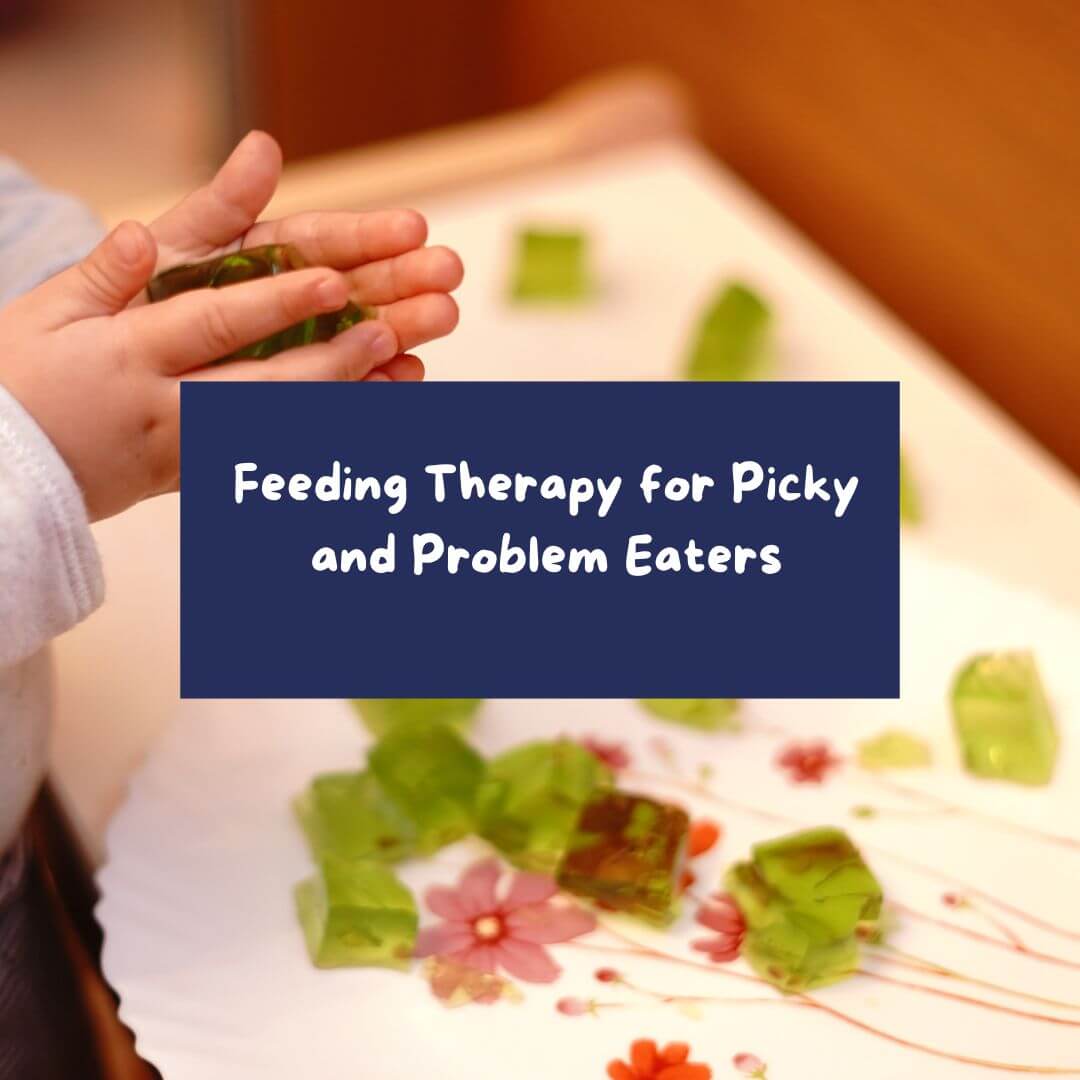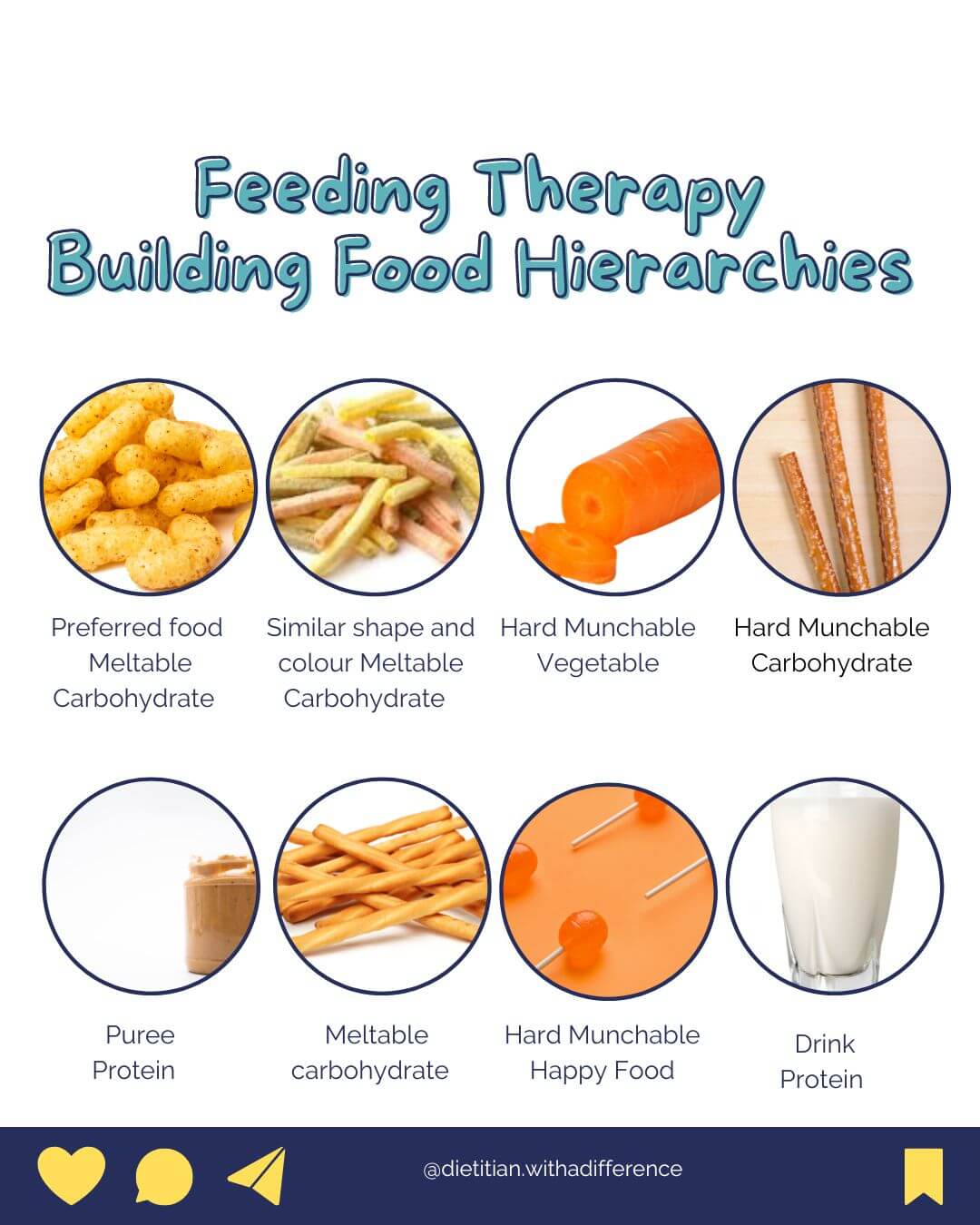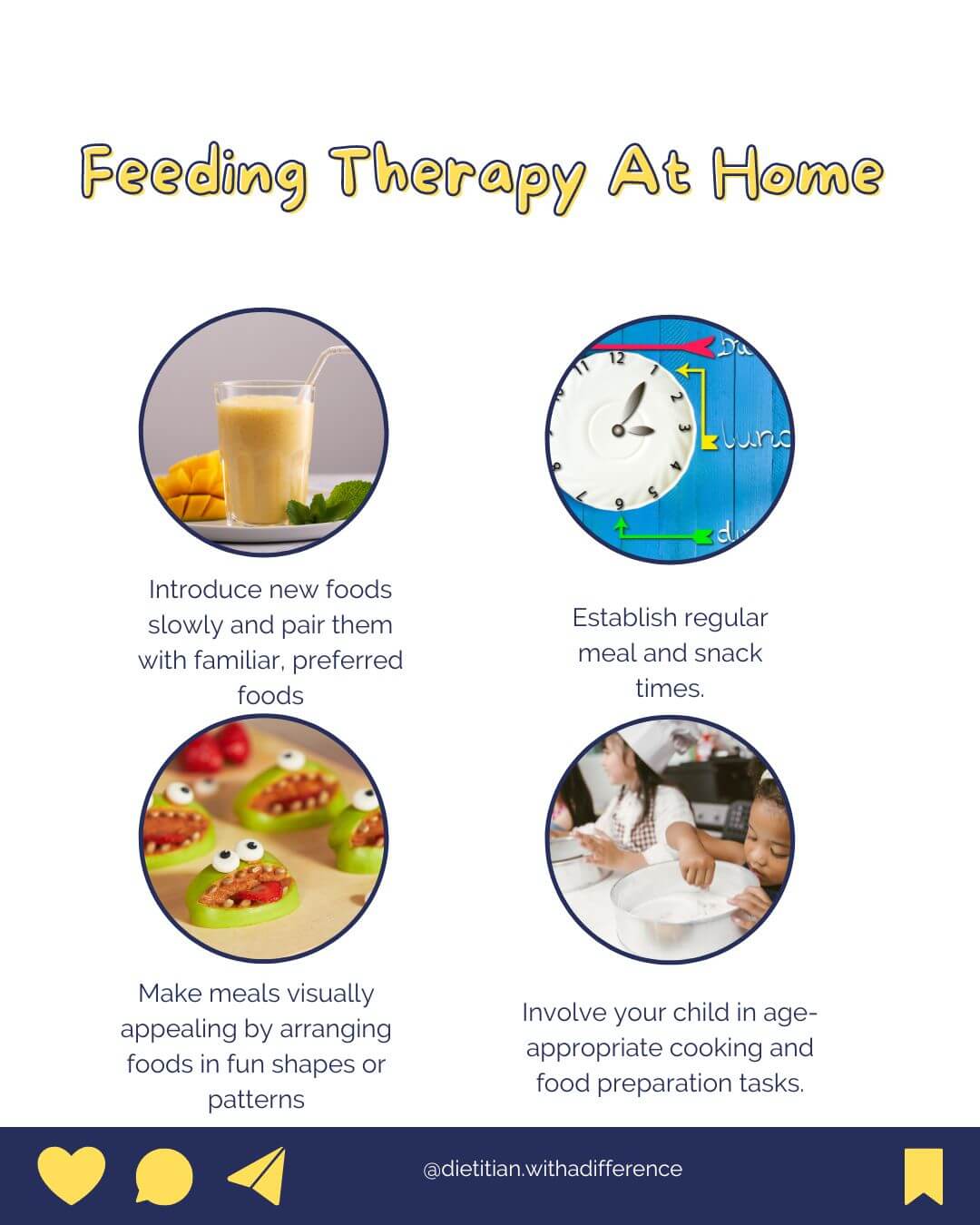In this blog, I will explain what feeding therapy is, who it is for, and how it can benefit your child. Additionally, I will share practical tips and strategies for implementing feeding therapy at home, and provide information on when to seek professional help.
Feeding issues can be a significant source of stress for families, and understanding the difficulties of these challenges is the first step toward finding effective solutions.
As a paediatric dietitian, a trained SOS feeding therapist and a mum who survived picky eating with my daughter. The purpose of this blog is to provide support and guidance for parents who are dealing with fussy eaters or problem eaters.
What is Feeding Therapy?
Feeding therapy is a specialised form of intervention designed to help children who face challenges with eating. These challenges can range from extreme picky eating to more severe feeding disorders that impact a child’s health, growth, and overall development.
Feeding therapy focuses on improving a child’s relationship with food, increasing their willingness to try new foods, and addressing any underlying issues that might be contributing to their feeding difficulties.
The primary goals of feeding therapy are to:
- Expand the variety and quantity of foods a child will eat.
- Reduce mealtime stress and anxiety for both the child and the family.
- Improve nutritional intake to ensure the child is receiving the nutrients they need in their diet.
- Address any sensory or motor difficulties that make eating challenging.
Feeding therapy typically involves a multidisciplinary approach, including input from dietitians, occupational therapists, speech therapists, and psychologists, to address the various factors that contribute to feeding difficulties.

Feeding Therapies
The approach of feeding therapy that I am trained in is the SOS approach (Sequential Oral Sensory). This approach was developed by Dr. Kay Toomey.
It focuses on:
- The sensory aspects of eating and encourages children to explore and interact with food in a play with purpose approach.
- Uses a step-by-step approach usually around 32 steps but there can be a lot more, gradually moving from tolerating food in the environment to touching, smelling, tasting, and eventually eating it.
- It focuses on creating positive experiences with food and reducing anxiety, which I found was so key in my daughter’s journey with fussy eating.
Key Components of Feeding Therapy
Feeding therapy encompasses several key components designed to address the diverse and often complex reasons behind a child’s feeding difficulties. These components work together to create a comprehensive approach that can help children expand their diet.
Sensory Exploration
Sensory exploration is a critical aspect of feeding therapy, especially for children who have sensory processing issues that affect their ability to eat a variety of foods.
Understanding Sensory Processing:
Children with sensory processing issues may be overly sensitive to the textures, smells, or tastes of foods. This can lead to strong aversions and refusal to eat certain foods.
Sensory exploration helps children become more comfortable with different sensory experiences related to food.
Techniques and Activities:
Food Play: Encourages children to interact with food in a non-threatening way, such as by touching, smelling, or playing with food items. This can reduce anxiety and build familiarity with different foods.
Gradual Exposure: Introducing new foods slowly and in a controlled manner
Building a Positive Relationship with Food
Creating a positive relationship with food is essential for overcoming feeding difficulties. This involves changing the way children and families perceive and approach mealtimes.
Positive Mealtime Environment:
Establishing a calm and pleasant atmosphere during meals to reduce stress and anxiety. Encouraging family meals where everyone eats together, modelling positive eating behaviours.
Avoiding Pressure
Pressuring children to eat can increase resistance and negative associations with food.
Instead, offering choices and allowing children to have some control over what they eat can empower them and reduce anxiety.
Making Food Fun:
Involving children in food preparation and cooking can increase their interest in trying new foods. Using creative presentation methods, like making food into fun shapes or involving storytelling, can make meals more enjoyable.
Addressing Oral-Motor Skills
For many children with feeding difficulties, challenges with oral-motor skills can be a significant barrier to successful eating. Oral-motor therapy focuses on strengthening the muscles and coordination needed for eating and swallowing. This is more of the focus for a speech and language professional.
Who is Feeding Therapy For?
Feeding therapy is designed to help children who experience significant challenges with eating that go beyond typical picky eating behaviours. It’s important for parents to understand the difference between normal picky eating and more serious feeding issues that may require professional intervention.
Download my FREE Picky vs Problem Checklist here

Identifying Problem Eaters vs. Picky Eaters
Picky Eaters:
Typical Developmental Phase: Most children go through phases of picky eating, especially during toddler years. This is often a normal part of development.
Picky eaters may refuse certain foods or prefer specific types of foods, but they generally consume a balanced diet over time.
Many picky eaters gradually expand their diet as they grow older and gain more exposure to different foods.
Problem Eaters:
Problem eaters exhibit more extreme and enduring eating behaviours that do not improve over time without intervention.
They often have a very restricted range of accepted foods, sometimes fewer than 20 different items.
Mealtimes can be a source of significant stress and anxiety for both the child and the family.
Their restricted diet can lead to nutritional deficiencies and impact their growth and development.
Signs Your Child Might Need Feeding Therapy
Parents should consider feeding therapy if they notice the following signs in their child:
Consistent Refusal of Foods:
The child regularly refuses to eat foods, especially new ones, despite multiple attempts over time.
Limited Diet (Fewer than 20 Foods):
The child’s diet is extremely limited in variety, with a strong preference for only a few specific foods.
The child may refuse entire food groups, such as fruits, vegetables, or proteins.
Stress and Anxiety Around Meals:
Meals often end in frustration, tears, or tantrums. Mealtimes are a source of stress for the child, leading to anxiety or behavioural issues.
The child may display physical signs of distress, such as gagging or vomiting, when presented with certain foods.
Feeding therapy is a comprehensive approach that can significantly improve a child’s eating habits, nutritional intake, and overall relationship with food. If you recognize any of these signs or issues in your child, seeking the help of a feeding therapist could be a beneficial step towards resolving these challenges and fostering a healthier, happier mealtime experience.
If you are worried click here to book a FREE call to see if you need more support.
How Can Feeding Therapy Help My Child?
Feeding therapy offers a structured and supportive approach to address and resolve feeding difficulties. It can have a profound impact on both the child and the family, leading to healthier eating habits and more enjoyable mealtime experiences.

Benefits of Feeding Therapy
Improving Nutritional Intake and Variety:
- Feeding therapy helps children accept a wider variety of foods, ensuring they receive the essential nutrients required for healthy growth and development.
- By gradually desensitizing children to the sensory properties of different foods, feeding therapy encourages them to try and accept new foods.
- With professional guidance, therapy can help identify and correct nutritional gaps in a child’s diet, which is crucial for their overall health.
Reducing Mealtime Stress for the Family:
- Feeding therapy focuses on making mealtimes less stressful and more enjoyable for everyone involved.
- Establishing regular mealtime routines and expectations helps reduce uncertainty and anxiety for both the child and parents.
- By making food exploration fun and non-threatening, children are more likely to engage with and try new foods, building an openness to different foods.
- Often involving a multidisciplinary team, feeding therapy provides holistic support that can include dietary adjustments, sensory integration techniques, and motor skill development.
How Can I Implement Feeding Therapy at Home?
While professional feeding therapy is highly effective, there are several strategies and techniques that parents can implement at home to support their child’s feeding development. Here are practical tips and approaches to help create a positive eating experience for your child.
Practical Tips and Strategies
Keep mealtimes calm and stress-free. Avoid distractions such as television or loud noises, and focus on making meals a positive experience.
Introducing New Foods in a Non-Stressful Way:
- Introduce new foods slowly and pair them with familiar, preferred foods. Offer new foods in small portions and avoid pressuring your child to eat them.
- Allow your child to explore new foods through play. Activities like making shapes with fruits and vegetables or creating food art can make new foods more appealing.
- Use sensory bins filled with different textured foods (e.g., dry rice, pasta) to help your child get used to touching and interacting with different foods.
Structuring Meals and Snacks:
- Establish regular meal and snack times. Consistency helps children know what to expect and can reduce mealtime battles.
- Offer a variety of foods from different food groups to ensure balanced nutrition. Serve age-appropriate portion sizes to avoid overwhelming your child.
Involving Your Child in Food Preparation:
- Involve your child in age-appropriate cooking and food preparation tasks. This can increase their interest in the foods they help prepare.
- Encourage your child to explore different ingredients, smell herbs, and taste new flavours while cooking.
Making Food Fun and Engaging:
- Make meals visually appealing by arranging foods in fun shapes or patterns. Use cookie cutters to create interesting shapes.
- Create stories or games around food.
- Involve your child in meal planning and food shopping. Let them pick out new food to try.

When to Seek Professional Help:
Signs It’s Time to Consult a Feeding Therapist or Paediatric Dietitian:
- Persistent and severe food refusal.
- Extremely limited diet (less than 20 foods).
- Significant stress or anxiety around meals.
- Concerns about growth or nutritional deficiencies.
- Presence of medical conditions affecting eating (e.g., reflux, food allergies).
What to Expect from a Professional Feeding Therapy Sessions:
Assessment: The therapist will conduct a thorough assessment to understand your child’s specific feeding issues and underlying causes.
Customised Plan: A tailored feeding plan will be developed to address your child’s needs,
Therapy Sessions: Regular therapy sessions will focus on gradually introducing new foods, improving eating skills, and reducing mealtime stress.
Addressing Feeding Issues Early
Early intervention is key to preventing long-term feeding problems and promoting healthy growth and development. By addressing feeding issues early, you can help your child develop positive eating habits that will benefit them throughout their life.
It’s important to understand that progress in feeding therapy takes time and patience. Be kind to yourself and your child, and celebrate the small successes along the way. Each positive experience with food builds towards a healthier, more varied diet.
. If you are worried, book a free call or check out my Creating Confident Eater Programme to see if I can help your child.
Written by Emma Shafqat, Paediatric Dietitian RD. The information is correct at the time of publishing the blog.

